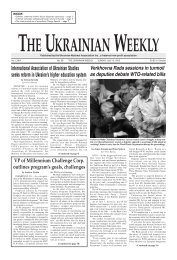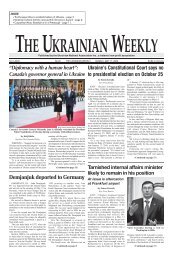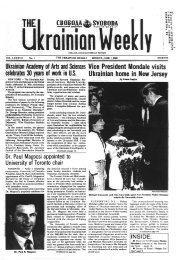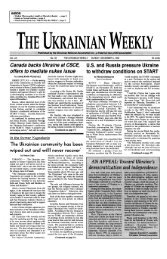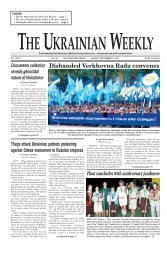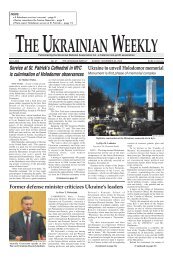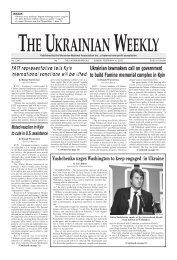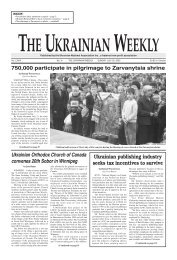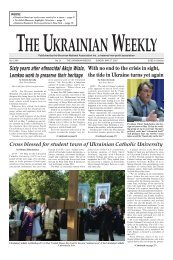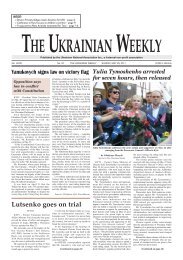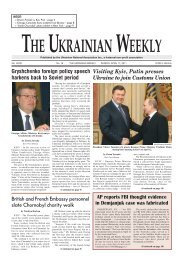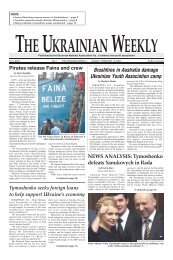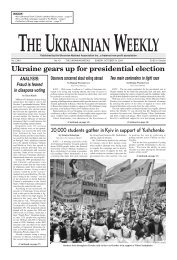1_January 6, 2002 - The Ukrainian Weekly
1_January 6, 2002 - The Ukrainian Weekly
1_January 6, 2002 - The Ukrainian Weekly
You also want an ePaper? Increase the reach of your titles
YUMPU automatically turns print PDFs into web optimized ePapers that Google loves.
6 THE UKRAINIAN WEEKLY SUNDAY, JANUARY 6, <strong>2002</strong><br />
No. 1<br />
Ukraine 10 years on: a social and economic review<br />
by Dr. David R. Marples<br />
In December 1991, over 90 percent of<br />
Ukraine’s residents ratified the declaration<br />
of independence in a national referendum.<br />
<strong>The</strong> new state was widely regarded as a<br />
potential economic giant. <strong>The</strong> second<br />
largest nation in Europe in terms of area, it<br />
possessed a population of 52.5 million, significant<br />
agricultural and industrial<br />
resources, and a highly educated workforce.<br />
What followed was unforeseen: a spectacular<br />
decline in the standard of living,<br />
accompanied by several disturbing demographic<br />
changes.<br />
In retrospect, Ukraine’s position was<br />
never as good as it seemed. It was complicated<br />
by several issues: relations with foreign<br />
powers and reliance on them for energy<br />
requirements, especially Russia; and the<br />
need to focus on security issues, to define<br />
borders with neighbors, and to construct<br />
the infrastructure of the new state from the<br />
ruins of the Communist one.<br />
Agriculture, the mainstay of the<br />
<strong>Ukrainian</strong> SSR was already producing less<br />
than Ukraine’s proportion of the Soviet<br />
Union. <strong>The</strong> coal and steel industries had<br />
been declining for a decade. <strong>The</strong>re was<br />
also a fear among political sectors of<br />
embarking too quickly on a program of<br />
radical economic reform, and perhaps<br />
above all the country was markedly regionalized,<br />
though this latter factor became<br />
more evident only in subsequent election<br />
campaigns and political events.<br />
This brief paper will address the various<br />
sectors of Ukraine’s social and economic<br />
life to analyze the situation after the first<br />
decade of independence. As a prequel, one<br />
might note that the retention and consolidation<br />
of independence are in themselves significant<br />
achievements.<br />
However, the success of the transition<br />
ultimately will be measured by factors such<br />
as living standards and quality of life, and<br />
by the image of the state abroad. In these<br />
areas, the state of Ukraine has not lived up<br />
to the high expectations, but it should not<br />
be viewed in isolation. <strong>The</strong> changes have<br />
been equally difficult in other post-Soviet<br />
states, though it is arguable that, given<br />
Western aid, advice, advisors and general<br />
support over at least the past seven years,<br />
Ukraine’s performance should have been<br />
better.<br />
Along with Belarus, Ukraine has had to<br />
deal with a prolonged dilemma from the<br />
nuclear disaster at Chornobyl. Only in<br />
December 2000, after numerous discussions<br />
and an agreement with the G-7 plus<br />
Russia and the International Atomic Energy<br />
Agency was the nuclear plant finally<br />
closed. <strong>The</strong> repercussions on health, agriculture<br />
and the economy, however, will<br />
continue for several decades.<br />
An overview<br />
In a recent talk here at the University of<br />
Alberta, my colleague Oleksii<br />
Omelianchuk discussed the “state capture”<br />
in Ukraine by business groups or oligarchs<br />
who have succeeded in creating vast<br />
wealth as a consequence. Such affluence<br />
does not pertain to the state sector or to the<br />
population as a whole. As the decade has<br />
progressed, Ukraine’s GDP has fallen<br />
below its 1991 value by 60 percent.<br />
Only over the past two years has some<br />
slight recovery been manifest, but this<br />
improvement in GDP and industrial output<br />
David R. Marples is professor of history<br />
at the University of Alberta in<br />
Edmonton and director of the Stasiuk<br />
Program for the Study of Contemporary<br />
Ukraine at the Canadian Institute of<br />
<strong>Ukrainian</strong> Studies, which is based at that<br />
university.<br />
This paper was originally presented at a<br />
panel titled “Quo Vadis, Ukraine?” held at<br />
the University of Alberta on December 3.<br />
is not expected to endure. <strong>The</strong> IMF, for<br />
example, forecast recently that the growth<br />
rate in Ukraine would slow in the year<br />
<strong>2002</strong>. Prime Minister Anatolii Kinakh has<br />
pointed to some serious structural defects<br />
in the way the <strong>Ukrainian</strong> economy operates,<br />
noting in particular that the bulk of<br />
exports is raw materials and products that<br />
require finishing outside the country. <strong>The</strong><br />
banking system, according to President<br />
Leonid Kuchma, is the weakest of all the<br />
post-Soviet countries, and the lending rates<br />
are so extortionate as to preclude factories<br />
and enterprises from being bold enough to<br />
run up debts.<br />
<strong>The</strong> demographic structure of Ukraine<br />
has changed significantly over the past<br />
decade. Over 72 percent of the population<br />
of Ukraine lives in towns, while the rural<br />
population has shrunk to less than 14 million<br />
people. <strong>The</strong> population as a whole has<br />
declined more rapidly than in any other former<br />
Soviet republic as the mortality rate is<br />
now substantially higher than the birth rate.<br />
In the year 2000 the population fell below<br />
50 million for the first time, and the total is<br />
anticipated to fall further to 48.1 million by<br />
2015 and 45.9 million by 2025, assuming<br />
there is no significant in-migration.<br />
Infant mortality in Ukraine, i.e., the<br />
deaths per thousand of babies that die<br />
before reaching the age of 1, is around 15 –<br />
three times higher than in Canada. Life<br />
expectancy at birth, which was 65.8 for<br />
men and 74.5 for women in the last five<br />
years of Soviet rule, today is 62.7 for men<br />
and 73.5 for women (14 and eight years,<br />
respectively, less than in Canada).<br />
In June 2001, at the special session of<br />
the United Nations General Assembly<br />
dealing with HIV/AIDS, it was revealed<br />
that over 250,000 residents of Ukraine are<br />
HIV positive, and that the disease has<br />
reached the status of a national epidemic.<br />
Similar pictures emerge when examining<br />
other infectious diseases in Ukraine, and<br />
health standards in general have declined<br />
because of a shortage of funding.<br />
Figures in Russia are comparable, with<br />
the proviso that one is not comparing like<br />
with like. As a federation, Russia possesses<br />
more extremes, from poverty-stricken<br />
regions such as Daghestan and the Far<br />
North, to the affluent and booming city of<br />
Moscow. Ukraine in that respect is much<br />
more uniform, though the agricultural<br />
regions of the west appear to have suffered<br />
more from the economic downturn than the<br />
industrial areas on the left bank of the<br />
Dnipro River.<br />
<strong>The</strong> industrial workforce has been prone<br />
to protest and strike against existing conditions,<br />
particularly the delays in receiving<br />
wages. One of the more poignant experiences<br />
of the decade of independence was<br />
the sight of unpaid workers from the<br />
Chornobyl nuclear plant protesting in Kyiv.<br />
In the year 1999 there were 327 strikes in<br />
Ukraine. <strong>The</strong> two major problems of the<br />
<strong>Ukrainian</strong> economy in 2001 (aside from<br />
corruption, which merits a separate discussion)<br />
are inflation and unemployment.<br />
Last year the inflation rate in Ukraine<br />
was over 25 percent, compared to 19.2 percent<br />
in 1999. Though the figure is well<br />
below the hyperinflation that pervaded the<br />
country in the early 1990s, it is still worrisome,<br />
and is accounted for by price<br />
increases for food and fuel. Recent agreements<br />
made with Russia on long-term pay-<br />
ments for debts on imported oil and gas<br />
may help to reduce inflation in the future.<br />
State debt remains high at around 54.6 billion<br />
hrv (around $9 billion U.S.)<br />
In the year 2000, the average wage in<br />
Ukraine was around $40 per month.<br />
According to the Infocus Program on<br />
Socio-Economic Security, about 37 percent<br />
of the population were considered to be<br />
living in poverty at the end of 1999, but<br />
this figure is likely an underestimate since<br />
the national minimum wage was around 41<br />
percent of the average wage – a sum that<br />
would be unlikely to sustain minimal subsistence<br />
levels.<br />
Unemployment officially stands at just<br />
over 12 percent of the workforce. But the<br />
real figure is also higher as numerous<br />
workers are on “administrative leave.” If<br />
one adds to the official list those who are<br />
not seeking work but are nonetheless part<br />
of the “able-bodied” population, the figure<br />
is over 26 percent. Those who do work are<br />
often not at their desks or workplaces, as<br />
absenteeism is around 20 percent.<br />
This overview of <strong>Ukrainian</strong> society and<br />
economy provides a portrait of a country in<br />
deep crisis. It is also one that is approaching<br />
a period when it may be cut off from<br />
Has the West been fair to Ukraine? Have<br />
we as Westerners expected too much too<br />
soon? Could one say that the problems that<br />
Ukraine faces today are a result more of<br />
the Soviet legacy than of its own making?<br />
trading links with neighbors such as<br />
Poland, which will become part of the<br />
European Union. Such a development will<br />
deprive Ukraine of significant border trade<br />
that provides a lifeline for many rural communities<br />
of western Ukraine. Though the<br />
EU appeared to consider associate membership<br />
for Ukraine several years ago, it<br />
has also made it plain that the present<br />
regime does not meet the rigid standards<br />
that would be acceptable to Europe.<br />
However, the gloomy perception of<br />
Ukraine by the international community<br />
may reflect, in part, the country’s inability<br />
to publicize its achievements, to “sell<br />
itself” to the West as a viable entity that<br />
still possesses the potential to develop a<br />
thriving market economy. Added to this<br />
problem is the dead weight of the legal<br />
intricacies and bureaucratic roadblocks that<br />
Western businesses face when they attempt<br />
to deal with Ukraine. President Kuchma<br />
has survived the political scandal of the<br />
death of journalist Heorhii Gongadze, but<br />
his standing could hardly be lower among<br />
those Western countries with which<br />
Ukraine wishes to deal.<br />
<strong>The</strong>refore, the question arises: Has the<br />
West been fair to Ukraine? Have we as<br />
Westerners expected too much too soon?<br />
Could one say that the problems that<br />
Ukraine faces today are a result more of<br />
the Soviet legacy than of its own making?<br />
Ukraine’s international image<br />
One year ago, the president of the<br />
<strong>Ukrainian</strong> National Academy of Sciences,<br />
Borys Paton, published a bitter article titled<br />
“If <strong>The</strong>y Had to Close Chornobyl in<br />
America,” which essentially made this<br />
same argument. Dr. Paton noted that<br />
Ukraine made two huge sacrifices, namely<br />
removing nuclear weapons from its territory<br />
voluntarily and closing the Chornobyl<br />
nuclear power station on December 15,<br />
2000. Dr. Paton noted that, despite their<br />
enormous significance both events hardly<br />
caused a stir within Ukraine.<br />
In his view, President Kuchma deserved<br />
“at least” a Nobel Peace Prize for the decision<br />
to close Chornobyl (the role of the G-<br />
8, EBRD, IAEA and others who pressured<br />
the president into such a decision is not<br />
mentioned in the article.)<br />
However, notes Dr. Paton, most<br />
<strong>Ukrainian</strong>s care little about international<br />
prestige because they are “living in misery.”<br />
In his view, <strong>Ukrainian</strong>s should project<br />
a certain image abroad, adopt certain ideas<br />
that reflect <strong>Ukrainian</strong> society and convey<br />
them to the political elite of the world.<br />
He points, in contrast, to the masterful<br />
way Russia handled the aftermath of the<br />
Kursk submarine tragedy, depicting on<br />
Russian television the images of the divers<br />
making repeated attempts to penetrate the<br />
submarine: “a devastating fiasco turned<br />
into a victory.” Why, he wonders, can<br />
Ukraine not exploit the closure of the<br />
Chornobyl plant in the same way?<br />
One answer might be that the Kuchma<br />
regime has destroyed its international credibility<br />
over the past seven years. <strong>The</strong> corruption<br />
(only Azerbaijan of the post-Soviet<br />
states is ranked as more corrupt than<br />
Ukraine according to Transparency<br />
International), the attacks on the media that<br />
include closures of anti-government newspapers<br />
and assassinations of individual<br />
journalists, as well as the general reluctance<br />
to permit large-scale private landholdings,<br />
to assist joint ventures and to<br />
undertake substantial economic reforms<br />
have all weakened that same public image.<br />
Ukraine’s Parliament has also acted as a<br />
millstone around the neck of the president,<br />
though the existence of a parliament with<br />
significant powers can be considered a<br />
democratic asset – no such Parliament<br />
exists in Belarus, and the Russian Duma is<br />
for the most part an ineffective talking<br />
shop. However, the plethora of political<br />
parties and electoral blocs only adds to the<br />
political stalemate and economic inertia.<br />
<strong>The</strong> situation has only been complicated<br />
by the events of September 11. <strong>The</strong> new<br />
relationship that Russia enjoys with NATO<br />
can only put pressure on Ukraine, with its<br />
avowed multi-vectored foreign policy that<br />
until recently was more oriented toward<br />
Europe than to the east. Russia has<br />
appointed former Prime Minister Viktor<br />
Chernomyrdin as the plenipotentiary<br />
ambassador to Ukraine, and it has declared<br />
the year <strong>2002</strong> to be the Year of Ukraine.<br />
<strong>The</strong>re could hardly be a better indication of<br />
President Vladimir Putin’s intention to<br />
draw Ukraine more closely into the<br />
Russian orbit, but it is not a direction that<br />
the <strong>Ukrainian</strong> government has shown any<br />
inclination to follow in the recent past.<br />
Conclusion<br />
After a decade one can assert that<br />
Ukraine has succeeded in several areas:<br />
political survival, the avoidance of civil<br />
strife, the promotion of a <strong>Ukrainian</strong> linguistic<br />
and cultural presence, and the resolution<br />
of problems such as the existence of<br />
nuclear weapons on its territory and the<br />
operations of the Chornobyl plant.<br />
However, even compared to its neighbors,<br />
it would hardly merit a passing grade<br />
if the last decade were regarded as an<br />
examination process. <strong>Ukrainian</strong>s have suffered<br />
an unprecedented decline in living<br />
standards over the past decade.<br />
Some of these dilemmas truly emerged<br />
from the Soviet era, such as obsolete industries<br />
in need of radical overhaul. But many<br />
of them did not, and can only be attributed<br />
to an uninspiring and often self-serving<br />
leadership that often seems to represent<br />
regional power blocs more than politicians<br />
with the interests of the country at heart.<br />
Not everyone will agree with my assessment.<br />
I have often had people say to me:<br />
Look at Kyiv, at the Mercedes and BMWs<br />
hurtling down the Kreshchatyk! Surely this<br />
is a sign that life is improving for Ukraine.<br />
Unfortunately the visible evidence of the<br />
success of new businessmen is hardly a<br />
(Continued on page 53)



